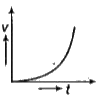A ball is thrown vertically upwards under the influence of gravity. Suppose observer A films this motion and play the tape backwards (so the tape begins with the ball at its highest point and ends with it reaching the point from which it was released), and another observer B observes the motion of the ball from a frame of reference moving at constant velocity which is equal to the initial velocity of the ball. The ball has a downward acceleration according to obsever.
A and B
only A
only B
neither
The correct Answer is:A
Acceleration w.r.t both will be downwards as acceleration of both frams themselves is zero
Topper's Solved these Questions
- BOOK - A2ZCHAPTER - GENERAL KINEMATICS AND MOTION IN ONE DIMENSIONEXERCISE - Relative Motion In One Dimension20videos
GENERAL KINEMATICS AND MOTION IN ONE DIMENSION
- BOOK - A2ZCHAPTER - GENERAL KINEMATICS AND MOTION IN ONE DIMENSIONEXERCISE - Understanding Motion Through Graphs40videos
GENERAL KINEMATICS AND MOTION IN ONE DIMENSION
- BOOK - A2ZCHAPTER - GENERAL KINEMATICS AND MOTION IN ONE DIMENSIONEXERCISE - Motion With Constant Acceleration30videos
GENERAL KINEMATICS AND MOTION IN ONE DIMENSION
- BOOK - A2ZCHAPTER - FLUID MECHANICSEXERCISE - Chapter Test29videos
FLUID MECHANICS
- BOOK - A2ZCHAPTER - GRAVITATIONEXERCISE - Chapter Test29videos
GRAVITATION
Similar Questions
Knowledge Check
- Question 1 - Select One
A ball is thrown vertically upwards under gravity. The velocity-time variation is represented by the graph
A B
B C
C D
D
- Question 2 - Select One
A ball is thrown vertically upwards in air. If the air resistance can not be neglected (Assume it be directly proportionalto velocity) thenthe acceleration of the ball at the highest point will be :
A0BgC>gD<g - Question 3 - Select One
A ball is thrown vertically upwards from the top of tower of height h with velocity v . The ball strikes the ground after time.
Avg[1+√1+2ghv2]Bvg[1+√1−2ghv2]Cvg(1+2ghv2)1/2Dvg(1−2ghv2)1/2
5A ball is thrown horizontally from a height of 20 m. It hits the ground with a velocity three times its initial velocity. The initial velocity of ball is
View SolutionA ball thrown vertically upwards with an initial velocity of 1.4 m/s returns in 2s. The total dispalcement of the ball is
View SolutionA ball thrown vertically upwards with an initial velocity of 1.4m/s. The total displcement of the ball is
View SolutionA ball is thrown vertically upwards from the ground. It crosses a point at the height of 25 m twice at an interval of 4 secs. The ball was thrown with the velocity of
View SolutionA ball is thrown vertically upwards from the ground. It crosses a point at the height of 25 m twice at an interval of 4 secs. The ball was thrown with the velocity of
View Solution

